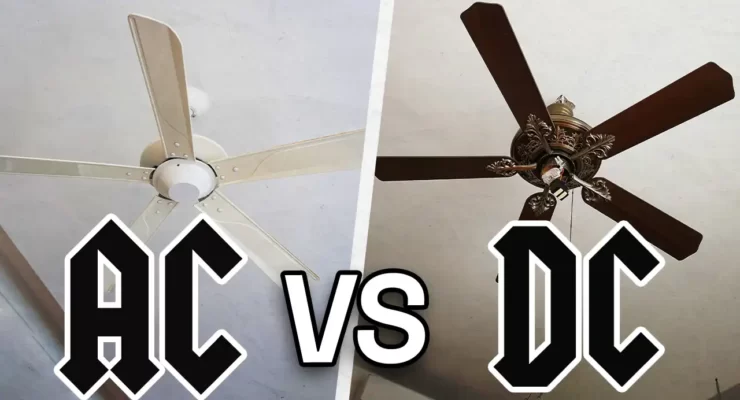
Fast read
Compared to AC ceiling fans, DC ceiling fans consume less energy and have more speed settings. If you are looking for a more efficient, quieter fan, a DC option may be the fan for you because they use magnets to work, leading to less resistance. Alternatively, AC fans use AC power and often have a maximum of three-speed settings.
DC fans can be turned into reverse and are remote-controlled. However, they may have trouble resetting themselves after a power interruption. In addition, the wall-mounted switch used to control AC ceiling fans makes it harder to operate them. Although DC ceiling fans are often more expensive than AC fans, they may eventually pay for themselves in energy savings.
When purchasing a fan, it is important to consider risk areas such as damage and rust—speaking with an experienced local supplier or installation before purchasing is recommended.
Should I choose an AC or DC ceiling fan model?
Ceiling fans with AC motors get power from active and neutral wires, similar to plugging into an electrical outlet. The speed at which these AC motors spin is intricately tied to the frequency and amplitude of their power source.
Because of this direct power connection and dependence on power source characteristics, maintaining a consistent speed with AC motors can be a challenge. As a result, these older ceiling fans typically offer a maximum of three-speed settings. Additionally, some models feature a reversible function, allowing them to operate in both summer and winter modes. To switch between these modes, users simply need to flick a switch on the fan.
The limitation to three-speed settings stems from the inherent characteristics of AC motors, making it challenging to achieve a broad range of speeds seamlessly. Although limited, many users find these fans useful for both cooling and warming because of their reversible mode.
Older ceiling fans that run on AC power may have fewer speed options. However, they are easy to use and can be used in both hot and cold weather. This makes them a good choice for different climates and preferences. As technology advances, newer options such as DC (Direct Current) fans offer more speed variability, but the simplicity and reliability of traditional AC ceiling fans continue to make them a popular choice in many households.
Direct Current (DC)
Domestic DC (Direct Current) powered ceiling fans have become more commonly available in the Australian market since 2010.
DC ceiling fans need a transformer that converts AC into DC. The transformer is either inside the motor housing or separated and located in the ceiling. As a result, DC ceiling fans have several advantages: they are more energy-efficient, offer more speeds, and are quieter.
Because they use magnets of opposing polarity to turn the blades, and this way, there is less resistance. Therefore, they use less electricity (up to 70%). Also, the flow is constant with DC, whereas AC changes polarity at 50 Hz.
When you look at the figures, DC ceiling fans use 70% less power in engaging marketing.
Alternate Current (AC)
An AC motor uses around 50 Watts per hour at high speed. In our example, one kW hour during peak tariff times costs $0.45.
So to run the AC ceiling fan for 20 hours will cost you 45 cents and to run the DC fan for 20 hours will only cost you 13.5 cents. Over time, the DC ceiling fan can pay for itself and the potentially slightly higher initial capital cost.
DC fans generally come only with a remote control and operate with a sender and receiver. It makes changing the direction for winter extremely easy. However, if there is a power outage, sometimes they can present issues with resetting, especially if you have misplaced the remote. No remote means you have no control over the fan, so maybe get a spare.

AC vs DC Ceiling fans – which should I choose?
When your ceiling fan relies solely on a wall-installed switch control, you may find that the switch lacks certain functions available on a remote control. This limitation can affect the convenience and versatility of operating your fan, as remotes often offer additional features not present in-wall switches.
DC ceiling fans cost more than AC fans but offer unique benefits, especially in bedrooms. DC ceiling fans are prized for their quieter operation, as the absence of humming coils reduces noise levels. This can be particularly beneficial for maintaining a peaceful sleep environment.
Functionality-wise, AC-powered fans are known for their limited control options, typically offering only 2 to 3-speed settings. On the other hand, DC-powered ceiling fans provide enhanced control with the capability of reaching up to seven-speed settings. A remote control allows you to easily change the direction of the fan. This feature is not always available with AC fans.
When considering outdoor installations, it’s essential to ensure that the chosen fan is specifically rated for outdoor use. In areas by the sea with high humidity and salt, regular steel and fittings can rust fast. This makes the ceiling fan look less appealing in a short amount of time.
Choosing a ceiling fan with stainless steel or wood blades is important in salty and humid areas. It helps prevent corrosion and lasts longer.
In summary, the choice between wall-installed switch controls, AC or DC ceiling fans, and outdoor-appropriate models depends on your specific needs and preferences. While AC ceiling fans may have limitations, DC ceiling fans offer more control and quieter operation, and outdoor installations demand materials resistant to rust and corrosion in coastal areas.


